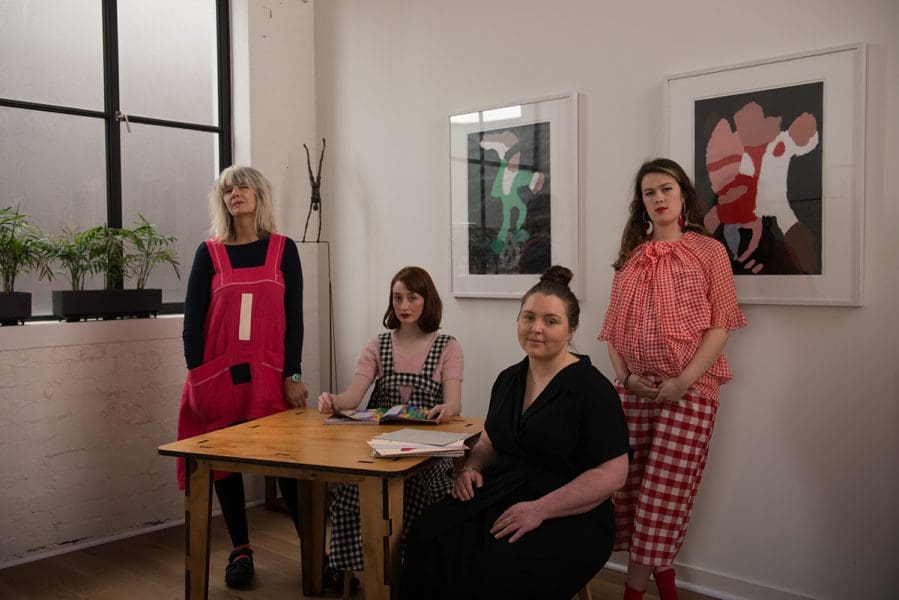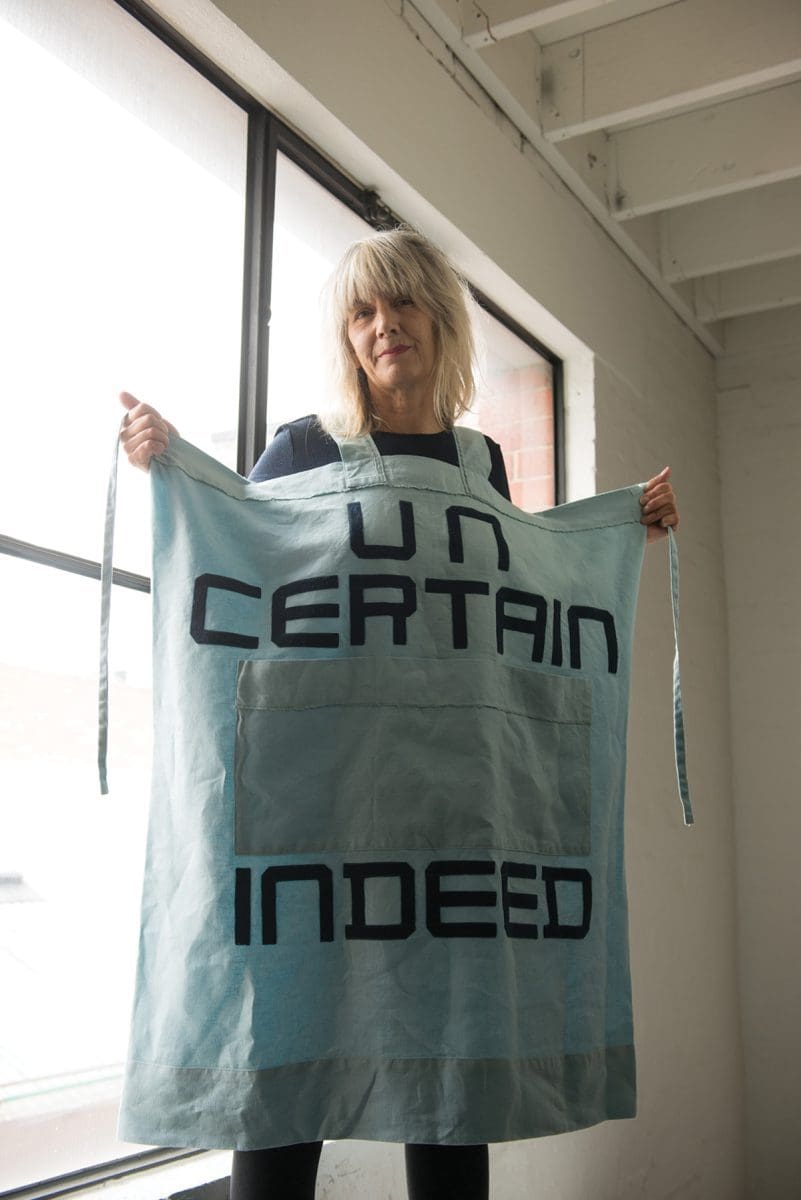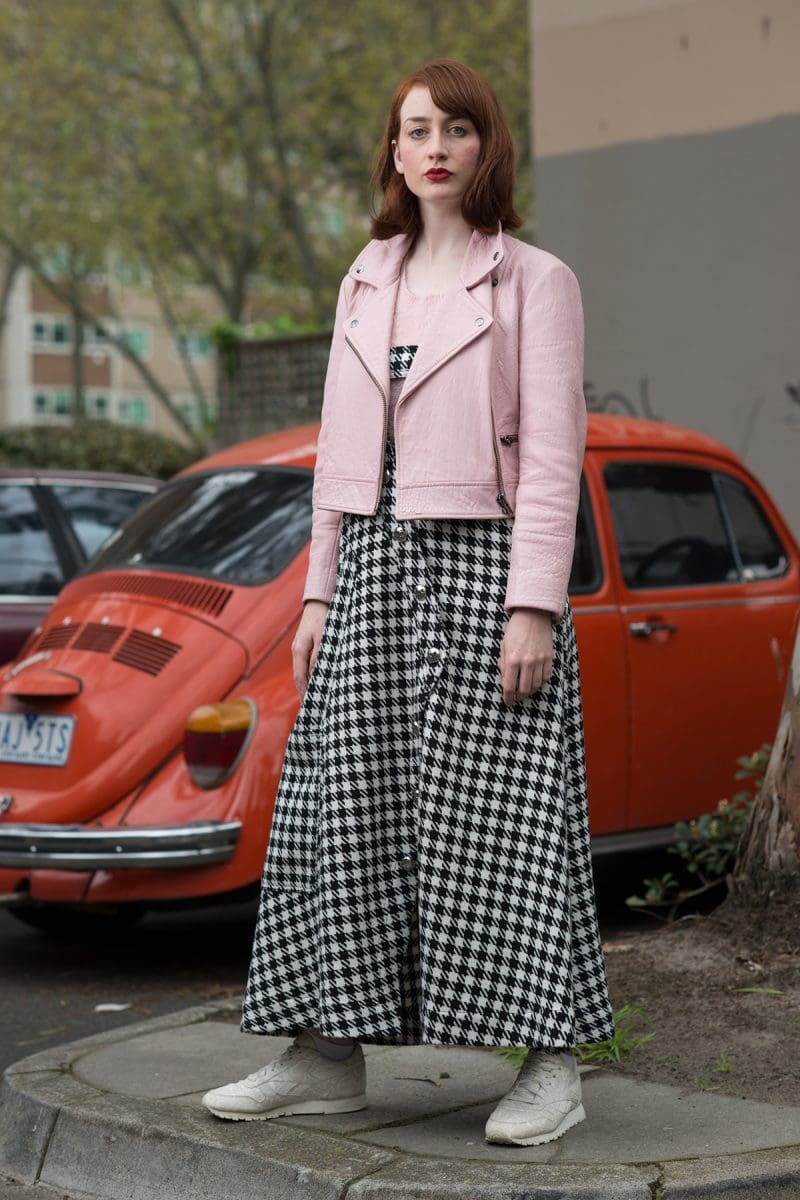
Piercing the veil
A new exhibition at Buxton Contemporary finds a rich complexity in the shadowy terrain between life and death.

L-R, Sarah CrowEST, Minna Gilligan, Cluny McCullagh and Ruth O’Leary. Photograph by Fred Kroh.

Ruth O’Leary, Tracey Dress, 2016, cotton and felt garment. Photograph by Fred Kroh.

Sarah CrowEST, Peregrinacáo, Sáo Paulo, 2016, wool on linen. Photograph by Fred Kroh.

Minna Gilligan. Photograph by Fred Kroh.
Fashion entered the art world in a very single-minded way. Like an attractive vampire, it was invited in through the front door. Its current pervasiveness, it is argued, stems from the notion of art as entertainment, positioned for mass appeal and maximum visitor numbers. Blockbuster fashion-based shows are proving popular and bringing a new audience into the museum.
The National Gallery of Victoria just opened Viktor&Rolf and Bulgari, and in Bendigo fashion has held the top spot regularly, with Melbourne designer, Toni Maticevski being the latest to be showcased. In this context, fashion and art is a collision of consumerism, luxury and desire, where we come to window shop, to ogle and Snapchat the spectacle. Meanwhile, outside the museum, fashion is co-opting artists like the Instagram-savvy, teen dream photographer, Petra Collins, by Gucci. Australian retailer Gorman has released a collection in collaboration with Mirka Mora.
Matthew Linde, PhD candidate in fashion and director of Centre for Style, a gallery and online space dedicated to fashion, isn’t surprised that fashion is taking over the gallery. He points out that this is not a new phenomenon – the beginning of the 20th Century saw fashion’s entry into art, though he acknowledges that it appears to be “mushrooming”.
It is since then Linde says, that “fashion has been understood as a cultural inquiry”, with “the contemplative space of the gallery… a suitable setting.” The debate over whether fashion is art, Linde intones, “has been exhausted countless times over.” The conversation about fashion and art may be well worn, but the way the crossovers occur makes the topic diverge from a singular strain.

In a room where the ways in which fashion and art intermingle are being discussed, I’d like to be eavesdropping on the artists who incorporate fashion or dress into their practice. These are the people who are turning over questions of feminism, identity and performance, and are providing an antithesis to the planned obsolescence of “Fast, disposal fashion,” says artist Sarah CrowEST.
Crowest has an ongoing project titled Peregrinations which involves attiring participants in specially made ‘strap-on’ paintings and appearing en masse at venues across Melbourne, and recently at the Sao Paulo and TarraWarra biennials.
Notably, after studying fashion and textile design in the UK as a teenager, CrowEST didn’t step into the space of a designer with her ‘garments’. ‘”I situate this aspect of my practice within the discourse of painting,” she says. ‘’I often make very large paintings on unstretched canvas which facilitates easy storage, and it’s a short step to strapping them onto the body.”
Similarly, emerging artist Ruth O’Leary works across performance, video and painting, and creates clothes called Fuck Dresses that are a mobile artwork. “It’s obvious that people read and judge each other through their dress, but there is a fine line between looking and interrogating.” In covering a white debutant-type dress with the hand painted expletive, her body becomes a Kruger-esque billboard. O’Leary is calling out the double standard –“There’s pornography everywhere and yet it is still provocative for a woman to wear a dress covered in the word ‘fuck’.”
For artist Minna Gilligan (an employee of Art Guide), fashion and art regularly intersect. Often she appears in her own work, recently as a gif video in her installation, Song outside my window at Heide Museum of Art or in her fashion-themed book Time After Time (Hardie Grant), where she sets herself as protagonist in her art. “Curated garments styled in specific ways heighten a sense of narrative, and enforce the idea of the protagonist,” she says. Gilligan talks freely about fashion, saying that dressing, though rarely admitted, has an “immense weight on identity at art school.”
Ruth O’Leary echoes that sentiment, “There isn’t much of a division between fashion and art in my practice or personal life…. I have always seen the act of dressing as an art form.” In using fashion as a mode of personal expression instead of interrogating it as oppressive, O’Leary and Gilligan redress feminism. “Fashion,” says Gilligan, “is most ardently feminist, in my mind.”
CrowEST, who refers to herself as a “feminist and older woman”, and chooses to dress in “utilitarian, functional, non-body revealing apparel” sees this style of dress as imparting “agency and strength.” Fashion is an external way of positioning ourselves in the world. “My apron paintings often feel like armor,” says CrowEST.

Themes, more accustomed to informing art than fashion, such as the body and gender, are turned over by fashion graduate and emerging artist, Cluny McCullagh. In McCullagh’s INTGRS 2014, items of indeterminate clothing were scattered over the ‘floordrobe’ for viewers to try on, to layer, to sculpt. Without prescriptive seams and with only a few cuts to guide wearers, clothing became free size and democratic. “I consider myself to be an intersectional feminist,” says McCullagh, “and [I] see contemporary fashion as a discipline.” “Fashion and art deal with culture and perspective. As long as they continue to do so they will intersect and reference one another,” she says. That intersection isn’t without friction, she admits.
Artists are using the tools of fashion – the lexicon, the forms and the imagery in a very cogent way to thrash out the ways in which it is problematic and the ways its potential to communicate and liberate. For instance McCullagh considers fashion to be “relatively egalitarian in dealing with issues of gender identity.”
“In the circles I participate in,” says Gilligan, “there is focus on diversity, fluidity and distinctiveness.”
As the artists gathered for the photo shoot for this article, the conversation took on a cautious tone, especially surrounding the power imbalance when fashion comes to art seeking legitimacy. One of the artists mentioned an offer of collaboration with a fashion brand with dismal imbursement. Crowest recalled an incident where one of her artworks was used on a children’s t-shirt by a large brand without permission. O’Leary responded. “Any subcultures get devoured by the machine of fashion and spat out as capitalist motifs.” As incursions across creative borders become deeper, artists are having to navigate some promising yet complex terrain.